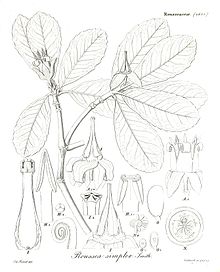Roussea
| Roussea | |
|---|---|

| |
| Drawing from Iconographia generum plantarum, F. Beck, 1838 | |
| Scientific classification | |
| Kingdom: | Plantae |
| Clade: | Tracheophytes |
| Clade: | Angiosperms |
| Clade: | Eudicots |
| Clade: | Asterids |
| Order: | Asterales |
| Family: | Rousseaceae |
| Subfamily: | Rousseoideae Horan. |
| Genus: | Roussea Sm. |
| Species: | R. simplex
|
| Binomial name | |
| Roussea simplex | |
Roussea simplex is a woody climber of 4–6 m high, that is endemic to the mountain forest of
Description
Stems and leaves
Roussea simplex is a liana of 4–6 m high. The wood vessels have very oblique oval openings which are subdivided by about 20 (maximally 50) bars (this is called scalariform), while the side walls have pits in rows and lack spiral-shaped thickenings. Its young stems are firm and have thick nodes. Leaves are set opposite to each other, but several pairs can be close to each other creating a whorl-like cluster. Stipules at the base of the leaf stems are absent, while the leaf stems themselves are about 1 cm long and are covered with felty hairs. The leaf blades are robust, large, and have a long inverted egg-shape (7–12 × 3–5½ cm). The base is rounded to slightly wedged, the margin is slightly serrated, particularly towards the tip and the tip is pointed or blunt. The top of the leaf blade is darker green and without hair, the underside is lighter and has some hair. The light green main vein splits pinnately and the secondary veins end at the leaf margin. The leaves contain long resin channels. Glandular peltate hairs are said to be present.[1][2]
Flowers
In the axis of the leaf mostly single (but occasionally up to four) pendulous flowers arise on a
Taxonomy
Taxonomic history
Roussea simplex was described in 1789 by
Modern classification
Phylogenetic analysis puts a clade consisting of Abrophyllum, Cuttsia and Carpodetus in the subfamily Carpodetoideae as sister to Roussea, on its own representing the Rousseoideae. Together these two make up the family Rousseaceae.[4]
Phylogeny
The following tree represents the current insights in the relationships of Roussea with other taxa.
| |||||||||||||
Reassigned species
One species that was described as Roussea has been reassigned to another family later on.[5]
- R. salicifolia = Pouteria salicifolia (Sapotaceae).
Etymology
Roussea was named after Jean-Jacques Rousseau.[4] The species epithet simplex is derived from Latin and means simple or characterized by one element.[6]
Distribution and habitat
Roussea simplex is an endemic climbing shrub of Mauritius, currently known to be confined in nine locations around the south-east, centre and south-west regions of the island.[7] This climbing shrub mainly grows in wet, high elevation cloud forests, such as at Le Pouce, Mauritius' highest mountain .[8]
Ecology
The flowers of Roussea produce copious amounts of nectar and are pollinated by the blue-tailed day gecko Phelsuma cepediana. The fruit secretes a gelatinous substance that contains the minute seeds. The blue-tailed gecko licks up this secretion and disperses the seeds in its droppings.[9] More recently, the Mauritius bulbul, Hypsipetes olivaceus was revealed as a more efficient pollinator of Roussea given its long beak and ability to fly longer distances.[10]
Pests and diseases
Conservation
In 1937 Roussea was common on Mauritius, but it is now considered
References
- ^ ISBN 978-3-540-31050-1
- ^ a b c James Edward Smith (1789). Plantarum icones hactenus. pp. VI. Retrieved 2016-03-18.
Roussea simplex.
- ^ Hansen, Dennis M. (2005). "Pollination of the enigmatic Mauritian endemic Roussea simplex (Rousseaceae): birds or geckos?" (PDF). Ecotropica. 11. Society for Tropical Ecology: 69–72.
- ^ . Retrieved 2016-03-17.
- ^ "Roussea". The Plantlist. Retrieved 2016-03-27.
- ^ "simplex". Dictionary.com. Retrieved 2016-03-17.
- .
- ^ "Roussea simplex". Encyclopedia of Life. Retrieved 2016-03-18.
- ^ JSTOR 20492551. cited on "Roussea simplex". Kew Royal Botanic Gardens. Retrieved 2016-03-17.
- .
- ^ "Plagiolepis madecassa". AntWiki: The Ants --- Online.
- .
- ^ Kerry Scott Walter; Harriet J. Gillett (1998). 1997 IUCN Red List of Threatened Plants. IUCN.
